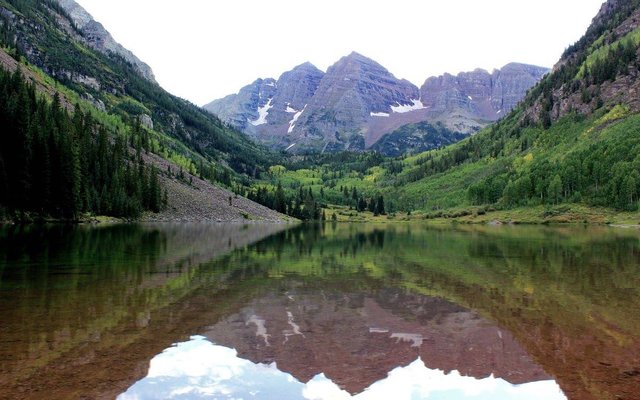Reflective Photography - Mountains (EXPLAINED)
Shot this image at the famous Maroon Bells mountain at Aspen, Colorado. They get their name as the mountains resemble the shape of three bells. Maroon Bells happens to be the most photographed mountain in the US, photographed by people at different times of the year. Most popular times to photograph the Maroon Bells are during spring and fall.
As a photographer who is always learning, I like to help others explaining the technique behind the shot to fellow enthusiasts and learners.

This photo of Maroon Bells was captured in early September at about 6:00 PM after sunset, with the following camera setting:
1. Focal length: 18mm
2. Aperture: f/11
3. Shutter Speed: 0.1 sec
4. ISO: 100
Camera used - Canon 60D, lens used - 18-55mm zoom lens. Tripod used.
1. Focal length & composition explained
Composition in simple terms is nothing but what to include in the photo and how to position the various objects in the frame. In this case, when shooting reflective shot of mountain in water, it is quite a basic necessity to make sure that the whole reflection is captured in the shot. Also given the position from which I was able to take the photo, it was important to use the lens focal length at the widest setting as possible to get as much of the scene as possible, hence 18mm. In short, my 18-55mm zoom lens was at its most zoomed out setting.
2. Aperture setting explained - f/11
Often times, when taking evening shots or under low lighting conditions, f-numbers beyond f/11 (f/14, f/22 etc.) tend to make the photo blurry. This again varies based on lens and the sensor size of your camera. However, to be safe f/11 is a good aperture setting to make sure this does not happen. For further information, please research "diffraction limit".
Aperture size directly decides the Depth of Field of the shot. Smaller the aperture, greater the Depth of field. Therefore, I selected a comfortable aperture size such as f/11, to keep the depth of field high enough to keep all objects in the scene in focus, at the same time not make the photo blurry due to diffraction.
3. Shutter speed explained - 0.1 seconds
Since the shot was taken in low lighting condition during evening, a slow shutter speed needed to be used to permit sufficient light onto the camera sensor for a bright image. Slower the shutter means greater the light, means brighter the photo. Also, slowing down shutter too much would have made the water and the reflective image of the mountain blurry due to the ripples and motion of the water itself. Therefore, used a comfortable shutter speed of 0.1 seconds.
At 0.1 seconds shutter speed, a camera tripod was used to take this photo. As a rule of thumb, at any speed lower than 1/30th of second, most photographers are unable to prevent the shake of their hand movement from causing a blur. Hence barring some exceptions, all long exposure shots are always taken with a tripod.
4. ISO setting explained - 100
ISO 100 denotes very low sensitivity of the camera sensor (the lowest value). Generally speaking, high ISO values such as 800, 1600, 3200 etc are used only in low light conditions such as indoor photography. Otherwise, in outdoor conditions and wherevever else permitted, ISO value should be kept as low as possible to prevent any grains, digital noise and get the highest quality image.
How this image could have been made better
During my travel, due to lack of a better choice of timing, I took this photo at about 6:00 PM in early September. At another time of the day, I could have captured the sunlight falling on the mountains which would have made for a better scene. Also, fall is one of the best seasons to capture Maroon bells, therefore had I taken the photo around late October - early November, it would have made for a better scene with beautiful fall colors. For composition, I used the widest angle setting of 18mm on my lens that was available with me. However a wider angle lens anywhere between 10-18mm focal length would have given a better composition.
Summary
1. Wide angle setting of 18mm used to capture the whole mountain, wider lens would have been better.
2. Aperture setting of f/11 used to prevent blur due to diffraction and to ensure a medium-high depth of field for the scene
3. Shutter speed of 0.1 seconds used with a tripod for proper exposure of the shot.
4. ISO 100 used for the highest quality image, keeping the sensitivity of the sensor low.
---------------------------------------------------------------------------------------------------------------------------------
As a photographer who is always learning from others, I like to share the technique behind my shot with fellow enthusiasts and learners. Any comments/criticisms are most welcome.
I maintain my photography profile on the social site VIEWBUG.COM
Heres a link to my bio on viewbug - https://www.viewbug.com/member/Krishna_Kumar#/Krishna_Kumar/bio
This photo originally uploaded by me on Viewbug, September 2014 - https://www.viewbug.com/photo/32605001
---------------------------------------------------------------------------------------------------------------------------------